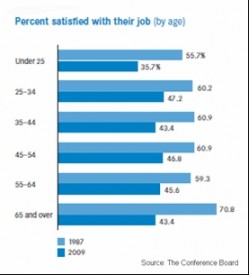![]() Earlier this month The Conference Board released the results of one of its periodic surveys saying less than half of American workers are happy at their job.
Earlier this month The Conference Board released the results of one of its periodic surveys saying less than half of American workers are happy at their job.
Out of 2,900 respondents to the survey, only 45 percent reported being satisfied with their job. In 1987, when the question was first asked, 61 percent reported being satisfied.
By now, the numbers may have changed. The survey was conducted last summer when huge monthly job losses were being reported and the unemployment rate was climbing. I should also point out that the survey is not without its challengers and that the results are at odds with other polls, notably the Gallup and University of Chicago, which found workers much more satisfied with their work.
Still, The Conference Board survey shouldn’t be dismissed out of hand. Its other surveys, including the much-watched Consumer Confidence Index, supports the suspicion that many of you have of a general worker malaise. A Salary.com survey released a year ago reported similar, though somewhat less dramatic, results.
 In any case The Conference Board survey clearly touched a nerve. Since its release there have been hundreds of blog posts mentioning it. And many more discussing a CareerBuilder survey conducted in November and released on Jan. 7 that says 19 percent of workers will jump ship in 2010.
In any case The Conference Board survey clearly touched a nerve. Since its release there have been hundreds of blog posts mentioning it. And many more discussing a CareerBuilder survey conducted in November and released on Jan. 7 that says 19 percent of workers will jump ship in 2010.
ERE blogger Rob Jannone talked about this a few days ago in a post he headlined “The Mass Exodus of Talent.”
“Halfway through the 1st month of 2010 and a theme emerging in the blogosphere and social media as it relates to Human Capital Management, is that the mass exodus of talent is imminent,” writes Jannone, who goes on to suggest three steps that might help to improve morale and reduce the potential exodus.
There’s one more bit of data to consider: least satisfied with their job are workers under 25 years of age.
What does this mean to recruiters? Depending on which side of the fence you happen to be on at the moment, it can be a boon helping you attract better talent. If you’re the one losing the workers, it means the internal pressure will go up as the remaining staff, already piled on with the workloads of the previously departed, have to cover, if only for “a while.”
The surveys, and a reading of the blogs and observations by recruiters and HR thought leaders, offers some scenarios for the coming months:
- High achievers, your best talent, will be the first to leave since they are in demand. Even now they’re doing their networking due diligence, waiting for the right opportunity to come along. That wasn’t so easy in 2009 when 4.2 million jobs disappeared. But in 2010, with every indication pointing to recovery, opportunities will begin to turn up.
- Young workers, many of whom took any job they could find, will bolt when they can. Some may be excelling in the careers they fell into and may stay because they’ve discovered they like it. The majority — 64 percent — are not happy. In such a large percentage inevitably will be good workers, performing well, who you would like to keep.
- Older workers who are in the age group typically most satisfied with their jobs, aren’t. They stay because the value of their investments and 401(k)s have fallen so far they can’t afford to retire,; they have fewer options due to age, and are less likely to relocate for work.
The implications of these scenarios, if unchecked and unaddressed, can easily lead to a workforce imbalance with dire consequences. I haven’t seen any of the bloggers predict imminent corporate collapse or anything but a slow, if mass, exodus. However, an incremental workforce change may mask its very effect.
Put those three scenarios together and you get a slow ebb of talent, beginning with the loss of promising young talent first. (Statistically speaking, based on The Conference Board’s demographic breakdown of dissatisfaction.) Simultaneously, top talent will leave. Not all of it, of course. But enough to have a noticeable effect. Finally — and this may be two or three years or more from now — older workers who have recovered financially will retire, taking with them the experience and knowledge that otherwise would have been passed down the line to the up and comers.
How likely is this picture of the workforce future? It is certainly a possibility if you do nothing. And there will be employers who do nothing. They will end up being among those who find themselves having to quickly fill vacancies, if only to keep the phones answered.
For everyone else, take a look at Jannone’s suggestions at the end of his blog post; see how your own workforce compares to the results of The Conference Board survey; and, do some workforce planning with your own scenarios.